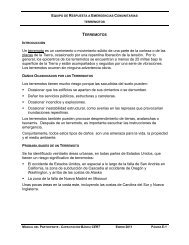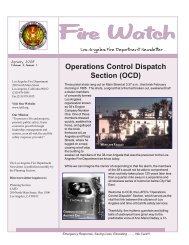FAMILY STEPS TO SURVIVAL - CERT Los Angeles
FAMILY STEPS TO SURVIVAL - CERT Los Angeles
FAMILY STEPS TO SURVIVAL - CERT Los Angeles
You also want an ePaper? Increase the reach of your titles
YUMPU automatically turns print PDFs into web optimized ePapers that Google loves.
Flashlights<br />
Flashlights can provide psychological comfort and<br />
immediate emergency light when disasters or other<br />
emergencies disrupt power. They’re good only when you<br />
can find them and the batteries work.<br />
Place a flashlight in every room; secure each one to<br />
ensure accessibility. Maintain an ample supply of extra<br />
batteries. Check them every six months.<br />
Lightsticks<br />
Lightsticks also are an excellent source of emergency light<br />
and do not require electricity or batteries to operate.<br />
Maintain an ample supply for each family member.<br />
Wall Units<br />
Emergency wall units that plug into electrical sockets and<br />
activate when electricity is disrupted also can provide<br />
emergency light during power outages.<br />
Radios<br />
Reliable information and instructions are essential after a<br />
damaging disaster or emergency. Protect yourself and your<br />
family by including battery-operated portable radios or<br />
televisions and extra batteries in your emergency<br />
preparedness kits.<br />
Special Needs<br />
Electrical outages also can impact persons with hearing<br />
impairments and others with special needs. Prepare NOW<br />
by including the following, as appropriate, in your<br />
emergency kits:<br />
□ Extra batteries for hearing aids, TDDs, wheelchairs<br />
□ Generator for life-safety equipment<br />
ESP <strong>FAMILY</strong> S TEPS <strong>TO</strong> S URVIVAL / S TEP 11, S IDE 2<br />
Checking Utilities<br />
Disasters can also damage utility lines and appliances,<br />
putting your home at risk to fire.<br />
Before the next emergency:<br />
□ Show responsible family members the location of your<br />
electrical service panel and teach them how to turn off<br />
service.<br />
□ Conduct family drills and simulate turning off electricity<br />
to test family skills.<br />
After the next emergency:<br />
□ Determine if electricity is out only in your home or<br />
throughout the neighborhood.<br />
□ Check for damaged appliances, as well as fallen,<br />
loose or damaged electrical wires.<br />
□ Disconnect damaged appliances.<br />
□ Stop power flow at the service panel if your wiring is<br />
damaged.<br />
□ Turn off gas only if you hear or smell a leak.<br />
□ Reenergize circuits by turning on the main panel first<br />
and then each breaker individually.<br />
□ Call the gas company to restore service. Do not turn<br />
the gas back on yourself.<br />
Sources included "Earthquake Awareness," <strong>Los</strong> <strong>Angeles</strong><br />
Department of Water and Power.<br />
Safety tip:<br />
Do not use candles, hurricane lamps, lanterns and other<br />
objects that rely on an open flame for lighting. Large and<br />
even moderate aftershocks that usually accompany<br />
damaging earthquakes can topple these items and cause<br />
fire. Items with open flames also can trigger explosions<br />
by igniting leaking gas.<br />
This project was supported by FY07 UASI funding awarded by the California Emergency<br />
Management Agency, through FEMA/DHS.<br />
This information sheet is produced as part of the Emergency Survival Program<br />
(ESP). ESP is an awareness campaign designed to increase home,<br />
neighborhood, business and school emergency preparedness. ESP was<br />
developed by the County of <strong>Los</strong> <strong>Angeles</strong>. The California Emergency<br />
Management Agency (Cal EMA) and representatives from Contra Costa,<br />
Imperial, Inyo, Kern, <strong>Los</strong> <strong>Angeles</strong>, Marin, Mono, Orange, Riverside, San<br />
Bernardino, San Diego, San Luis Obispo, Santa Barbara, Santa Cruz, and<br />
Ventura counties, Southern California Edison, the Southern California Earthquake<br />
Center and the American Red Cross assist in the development of campaign<br />
materials and coordination of the campaign.




